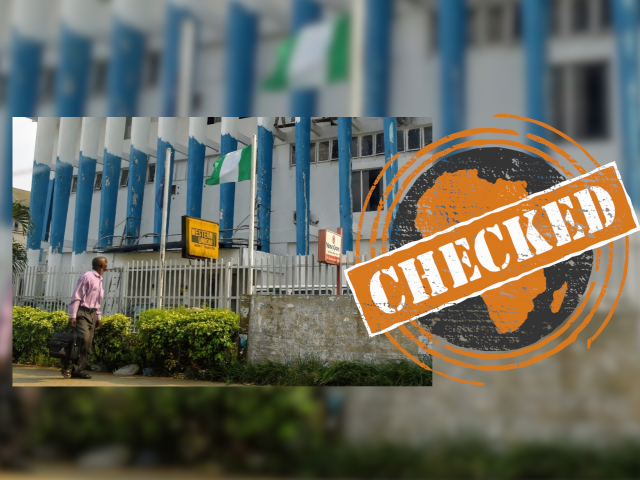Latsa nan don karanta wannan rohoton da Hausa. Click here to read this report in Hausa.
A graphic doing the rounds on Facebook shows a small child lying their side with blackened, cracked skin over half their body.
“This boy's skin have been peeling off since He was bitten by this insect,” the text reads. An inset photo shows what looks like a centipede.
“Doctors said they don't have any treatment for it's venom because it has Not been discovered by scientist,” it continues. It then asks users to share the graphic, and “pray for this dying child”.
The claim has been repeated on Nairaland Forum, a Nigerian discussion forum.
Did an insect bite cause the damage to the child’s skin?

Two specialists told Africa Check that the child’s skin disorder was not as a result of a centipede bite.
Dr Idika Kalu, a senior lecturer at the department of veterinary parasitology and entomology at the University of Nigeria in Nsukka, confirmed that the insect in the graphic was a centipede.
“However, there is no documented evidence of centipede causing this kind of lesion,” he said.
Dr Terry Ezeudu, a veterinary doctor, said she could not conclusively say the child’s condition was a result of the centipede bite.
“I have not seen such before,” she told us. “This is an extensive lesion; it looks more like a fungal growth as it is leathery in appearance. Further investigations need to be done – a skin scraping and culture or biopsy. There is a possibility a skin disorder like this exists.”
Centipede stings can be painful but rarely cause health complications in people, and aren’t dangerous. The sting can be identified by swelling and redness.
There is no evidence the child in the graphic was stung by a centipede. – Motunrayo Joel
Wani hoto da ke ta yawo a kafar sada zumunta ta Facebook na nuna wani yaro kwance yayin da gefen jikinsa ya yi baki kuma a tsatstsage.
“Fatar yaron na ta fita tun bayan da wannan kwaron ya cije shi,” rubutun da ke biye da hoton ya ce. Hoton kwaro.
“Likitoci sun ce basu da maganin dafin cizon kwaron, har yanzu ba’a samu maganin dafin ba,” rubutun ya cigaba da bukatar masu karatu da su cigaba da yada hoton don jama’a su yiwa yaron da ke daf da mutuwa addua.
Wannan rubutu an sa ke yada shi a shafin Nairaland Forum, wani zauren tattaunawa na yanar gizo.
Shin cizon kwaron ne ya jawo tsatsagewar fatar yaron?

Wasu masana sun shaidawa Africa Check cewa lalular da ta danganci fata ce ke damun yaron ba cizon kwaro ba.
Dr Idika Kalu, babban malami a sashen kula da lafiyar dabbobi na jami’ar Najeriya da ke Nsukka ya tabbatar cewa kwaron da akafi sani da shanshani ne jikin hoton
“Amma ya ce babu wata hujja da zata tabbatar cewa kwaron zai iya jawo irin wannan lalura.”
Dr Terry Ezeudu, babbar likitar kula da dabbobi, ta ce ba zata iya cewa cizon kwaron ne ya jawo wa yaron lalurar ba.
“Ban taba ganin makamancin wannan ba,” likitar ta ce. “Matsanantan raunuka ne; sun fi kama da kwayoyin cutar da ke shafar fata, duba da yadda yanayin fatar ya ke. Tilas ne a kara wasu binciken. Zai iya kasancewa akwai matsalar fata makamanciyar wannan.”
Cizon shanshani na da zafi amma da wuya ya ke jawo wata matsalar da ta danganci lafiyar jikin dan adam, za’a iya gane wajen da kwaron ya ciza a jiki kasancewar wajen zai kumbura kuma yayi ja.
Babu wata hujja da ta tabbatar cewa yaron da ke cikin hoton shanshani ne ya cije shi. – Motunrayo Joel
A graphic doing the rounds on Facebook shows a small child lying their side with blackened, cracked skin over half their body.
“This boy's skin have been peeling off since He was bitten by this insect,” the text reads. An inset photo shows what looks like a centipede.
“Doctors said they don't have any treatment for it's venom because it has Not been discovered by scientist,” it continues. It then asks users to share the graphic, and “pray for this dying child”.
The claim has been repeated on Nairaland Forum, a Nigerian discussion forum.
Did an insect bite cause the damage to the child’s skin?

‘More like a fungal growth’
Two specialists told Africa Check that the child’s skin disorder was not as a result of a centipede bite.
Dr Idika Kalu, a senior lecturer at the department of veterinary parasitology and entomology at the University of Nigeria in Nsukka, confirmed that the insect in the graphic was a centipede.
“However, there is no documented evidence of centipede causing this kind of lesion,” he said.
Dr Terry Ezeudu, a veterinary doctor, said she could not conclusively say the child’s condition was a result of the centipede bite.
“I have not seen such before,” she told us. “This is an extensive lesion; it looks more like a fungal growth as it is leathery in appearance. Further investigations need to be done – a skin scraping and culture or biopsy. There is a possibility a skin disorder like this exists.”
Centipede stings can be painful but rarely cause health complications in people, and aren’t dangerous. The sting can be identified by swelling and redness.
There is no evidence the child in the graphic was stung by a centipede. – Motunrayo Joel
Babu wata shaida da ta nuna cewa yanayin yadda fatar wani yaro ta yi sakamakon cizo ne daga wani kwaro
Wani hoto da ke ta yawo a kafar sada zumunta ta Facebook na nuna wani yaro kwance yayin da gefen jikinsa ya yi baki kuma a tsatstsage.
“Fatar yaron na ta fita tun bayan da wannan kwaron ya cije shi,” rubutun da ke biye da hoton ya ce. Hoton kwaro.
“Likitoci sun ce basu da maganin dafin cizon kwaron, har yanzu ba’a samu maganin dafin ba,” rubutun ya cigaba da bukatar masu karatu da su cigaba da yada hoton don jama’a su yiwa yaron da ke daf da mutuwa addua.
Wannan rubutu an sa ke yada shi a shafin Nairaland Forum, wani zauren tattaunawa na yanar gizo.
Shin cizon kwaron ne ya jawo tsatsagewar fatar yaron?

‘Ya fi kama da wata lalurar da ke kama fata’
Wasu masana sun shaidawa Africa Check cewa lalular da ta danganci fata ce ke damun yaron ba cizon kwaro ba.
Dr Idika Kalu, babban malami a sashen kula da lafiyar dabbobi na jami’ar Najeriya da ke Nsukka ya tabbatar cewa kwaron da akafi sani da shanshani ne jikin hoton
“Amma ya ce babu wata hujja da zata tabbatar cewa kwaron zai iya jawo irin wannan lalura.”
Dr Terry Ezeudu, babbar likitar kula da dabbobi, ta ce ba zata iya cewa cizon kwaron ne ya jawo wa yaron lalurar ba.
“Ban taba ganin makamancin wannan ba,” likitar ta ce. “Matsanantan raunuka ne; sun fi kama da kwayoyin cutar da ke shafar fata, duba da yadda yanayin fatar ya ke. Tilas ne a kara wasu binciken. Zai iya kasancewa akwai matsalar fata makamanciyar wannan.”
Cizon shanshani na da zafi amma da wuya ya ke jawo wata matsalar da ta danganci lafiyar jikin dan adam, za’a iya gane wajen da kwaron ya ciza a jiki kasancewar wajen zai kumbura kuma yayi ja.
Babu wata hujja da ta tabbatar cewa yaron da ke cikin hoton shanshani ne ya cije shi. – Motunrayo Joel
Republish our content for free
For publishers: what to do if your post is rated false
A fact-checker has rated your Facebook or Instagram post as “false”, “altered”, “partly false” or “missing context”. This could have serious consequences. What do you do?
Click on our guide for the steps you should follow.
Publishers guideAfrica Check teams up with Facebook
Africa Check is a partner in Meta's third-party fact-checking programme to help stop the spread of false information on social media.
The content we rate as “false” will be downgraded on Facebook and Instagram. This means fewer people will see it.
You can also help identify false information on Facebook. This guide explains how.





Add new comment